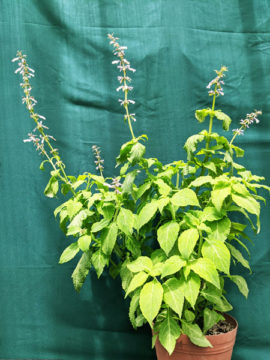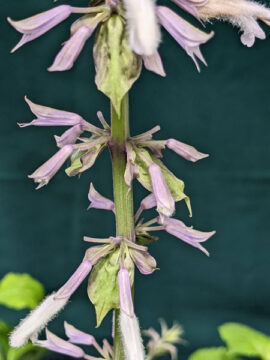FAMILY: LAMIACEAE
Small plants $300 pesos. (Not available at this time)
DIVINE SAGE, PIPILTZINTZINTLI, XTA (SKA) PASTORA, YERBA DE MARIA: This plant is used by the Mazatec Indians of Oaxaca, Mexico, for telepathy and clairvoyant insights.
This sage has square, winged stems and large (to 8″ long) fragile, dark green, almost iridescent leaves on a sprawling plant to 2 meters tall. Has hairy white ¾” flowers within purple bracts and calyxes. It flowers in winter, with flowering triggered by a day-length of 11 hours.

Grow in rich jungle soil or in a very large pot with a loose, moist, very rich soil mix high in humus. Tender to about 25°f. although will be damaged by any amount of frost. Salvia likes cool, 80° summer temperatures with high humidity: mist in hot weather or keep in a high-humidity (above 60%) environment.
Salvia has a light scent and a bitter taste, sunburns easily (grow in heavy shade) and is the favorite food of many plant creatures and pests. Native shamans use(d) it by making a tea of 50-60 dried leaves (not well absorbed through the intestinal tract) or by keeping 6-18 chewed fresh leaves in the mouth (being absorbed through the mucus membranes of the mouth, a somewhat difficult but not impossible task because of the bitterness). The dried leaves may be smoked, a much more effective method of ingestion.
CAUTION: If you are in Mexico and you ask herbalists or regular nurseries for “salvia” you will most likely get Aloe vera. “Salvia” is what Aloe is called here and it’s a very popular medicinal herb.
There have been many “strains” of Salvia divinorum sold. Some are variations grown from seed and some are strains collected for various local shamans. We no longer grow any of these “strains.” I see no point to it. The Salvia we sell is a generic “strain” I obtained from an anonymous collector here in Mexico. The following strains are listed for historical reference, only.

- “Blosser” (Palatable) strain: A descendant of a Salvia divinorum plant brought from Mexico to the USA by anthropologist, Bret Blosser, in the 1990s. Some people think that it is slightly less bitter tasting than the other clones.
- “Cerro Quemado” strain: A descendant of a Salvia divinorum plant collected by L.J. Valdes III, (the first person to isolate Salvinorin A, the active chemical in Salvia divinorum) near the village of Cerro Quemado, Mexico in the 1990s. Two good links for background information on this strain: Valdes, 1987, and Valdes, 1983.
- “La Fuerza” (The Force) strain: A strain collected by Kathleen Harrison, ethnobotanist and former wife of Terence McKenna, in January, 2001.
- “Hofmann & Wasson” strain: A descendant of the original Salvia divinorum plant brought from Oaxaca, Mexico, to the USA by Hofmann and Wasson in 1962.
- “Julieta” strain: A strain collected by Daniel Siebert from a Mazatec shaman in Huautla de Jimenez (in the Sierra Mazateca, Mexico) in 1999.
- Salvia divinorum “Luna” strain: A descendant of a Salvia divinorum plant growing under a Hofmann & Wasson clone, found by Daniel Seibert in Hawaii in 1994. this is possibly a seedling or a sport (mutation). It has a slightly different leaf form (more rounded and the edges more serrated) than the other clones listed here.
- “Owens” strain: A strain collected by Jack Owens on Cerro Rabon (in the Sierra Mazateca, Mexico) in June, 2003. Jack Owens was a major supplier of dried Salvia divinorum leaves to the US from Mexico. He died at the beginning of September, 2004 and this strain is named in his honor.
- “Paradox” strain: A cutting from a seed-grown strain raised by Daniel Siebert in 1994. Salvia divinorum derived from seed grown plants is very rare and should be valuable genetically.
- “Resilience” strain: A cutting from a seed-grown strain raised by Daniel Siebert in 2002.
LINKS FOR MORE INFORMATION:
- National Library of Medicine – The current science…
- Wikipedia
- Salvia divinorum Epling et Jativa by Jonathan Ott – Great research.
- Sagewisdom.org – A great resource that seems to no longer exist…
- EROWID
- Studies of Salvia divinorum (Lamiaceae), an Hallucinogenic Mint from the Sierra Mazateca in Oaxaca, Central Mexico – Economic Botany 41(2), 1987 – Great original research.